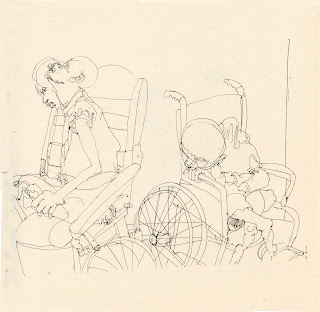Cober didn't wait for a client to send him to homes for the aged. He went there on his own.
He also visited prisons and drew what he found there.
A series of Cober's drawings from mental institutions, prisons, and homes for the aged were published as a book about abandoned people called
The Forgotten Society.
What did Cober hope to accomplish? If he was a lawyer he might have filed a lawsuit. If he was a politician he might have passed a law. If he was a TV journalist he could have reported the facts. Instead, he was an artist. As the ancient philosopher Cicero wrote:
"Such strengths as a man has, he should use."
So, what strengths did Cober have? Look at the way he presented this scene:
The faces and personalities of the human subjects have vanished into dehumanizing machines, with only a few pathetic limbs dangling out:
Lawyers or politicians could never convey the story of humans caught in the machine this way.
In this next drawing, Cober focuses on a person in a wheel chair to show us how different the reality is from our shorthand recollections:
You don't learn anatomy like this in an art class.
In the following drawing, Cober identifies a small point of irony...
... then prioritizes it by stripping away the rest of the world's clutter and placing the irony at the juncture of a long horizontal and a long vertical:
These are the strengths of an artist. And such strengths as a person has, they should use.


























